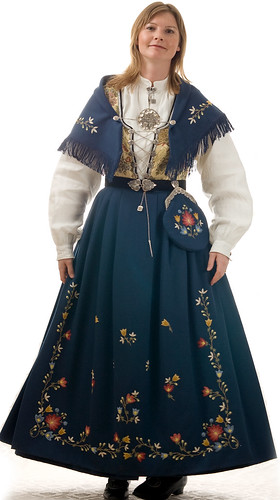My mom is 100% Norwegian. Her father and her mother's mother immigrated here. Her heritage has always had a subtle influence on her, in the foods she eats and the way she decorates her house. After taking a social psychology class and doing a report on cultural beliefs and upbringing, I can see the influence in how I was raised beyond just eating lefsa* at Thanksgiving and pulling the batteries out the smoke detector before making krumkake**. I've always had an appreciation of all things Scandinavian, particularly the everyday art like rosemaling and the embroidery inspired by it.
Which is perhaps why I've had a deep passion for the bunad, the Norwegian national costume.
(All images found from simply Googling "bunad")
A few years ago, my Aunt Thelma passed away. I didn't know her (in fact, I'm not sure I ever met her), but I'd always assumed she was one of my maternal grandma's siblings. Grandma came from a large family, so it made sense. My mother was mentioned in Thelma's will, and so a copy of it was sent to her . . . along with a family tree. Thelma was not my grandma's sister, as I'd always supposed. She was the half sister of my grandma's mother, Elise. Apparently my grandma's grandmother was married, widowed, and remarried, resulting in four children total. She also had the most ridiculously awesome name ever: Gunhilde Haldordatter. Gunhilde means "battle maiden" and Haldor is a male name meaning Thor's lightning (datter means daughter, showing linage)***. With such an amazing name, I've always wondered about her and her life.
I have the clock my grandma's parents got as a wedding gift, and they were married around 1910, I believe. Assuming Elise married at 20, for easy math, that means she was born around 1890, putting Gunhilde as a young adult right through the 1880s using lazy math and assumptions, but it gives me a place to start.
Wikimedia then gave me this:
 |
| Christian Krohg - Albertine "to see the police surgeon" created between 1885 - 1887 |
Being that are no free patterns for bunads and information on them is extremely limited, I based mine on images around the internet, the fabric requirements from this blog, and this guide for making a dirndl (since they are similer). I used cotton flannel instead of wool, since this was a trial run, and bought 4.5 yards instead of 3.5 because my fabric was narrower. This was my first mistake. That made for far too much skirt and ugly pleating. I also made it for my normal (non-corseted) waist.
I cut off two strips for the waistband, and then cut the rest of the fabric into quarters and sewed the panels together selvage to selvage to make the skirt. (I left a few inches unsewn at the top of one for the opening.) Then I took some gingham remnant I got for a steal and stitched to the waist.
 |
| Herringbone stitch to cover raw edges |
 |
| Up, down, up, down |
The gingham saves you from having to mark the fabric, and provides extra body to the fabric being pleated. The pleating was too deep, and the bottom two rows were removed later. Another problem was not cartridge pleating enough of the fabric. I pleated half of the total skirt, meaning the knife pleats on the front had to be very deep to take up the rest of the fabric. I should have taken another yard at least.
I stitched on the waistband, and was so thoroughly out of love with this project that I will not be hemming it or adding a closure.
From the front (hips!)
Side proves that the woman in the painting wouldn't have needed a bustle pad if the back of the skirt was cartridge pleated.
Close-up of beautiful cartridge pleats
And close-up of ugly knife pleats. The wide box pleat in the front ended up off center because there was sooo much fabric to deal with, and I accidentally put the opening on the right side.
*lefsa is a Norwegian potato tortilla
**krumkake is a crunchy cookie kinda like a pizzelle. I think they taste like a waffle cone.
***Name translations may be wrong, however please don't correct them unless the truth is even more awesome than I believe. :)
The breakdown:
The Challenge: Heritage and heirlooms
Fabric: 4.5 yards black cotton flannel, black and white cotton gingham
Pattern: My own, based on what information I could find
Year: 1887, but is probably correct for a long range of time periods
Notions: Black cotton thread.
How historically accurate is it? Cotton should be wool, and the hem should have a facing, but it is entirely hand sewn. 60%?
Hours to complete: Somewhere around 20 hours
First worn: Never, and probably never will be, but it was a good learning experience.
Total cost: About $20. The flannel was on sale, the gingham remnant was only about $1 and I had all the thread on hand from other projects.








No comments:
Post a Comment